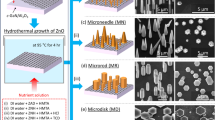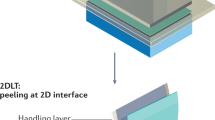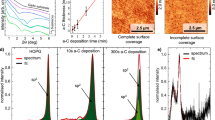Abstract
Remote epitaxy, in which an epitaxial relation is established between a film and a substrate through remote interactions, enables the development of high-quality single crystalline epilayers and their transfer to and integration with other technologically crucial substates1,2. It is commonly believed that in remote epitaxy, the distance within which the remote interaction can play a leading part in the epitaxial process is less than 1 nm, as the atomically resolved fluctuating electric potential decays very rapidly to a negligible value after a few atomic distances3. Here we show that it is possible to achieve remote epitaxy when the epilayer–substrate distance is as large as 2–7 nm. We experimentally demonstrate long-distance remote epitaxy of CsPbBr3 film on an NaCl substrate, KCl film on a KCl substrate and ZnO microrods on GaN, and show that a dislocation in the GaN substrate exists immediately below every remotely epitaxial ZnO microrod. These findings indicate that remote epitaxy could be designed and engineered by means of harnessing defect-mediated long-distance remote interactions.
This is a preview of subscription content, access via your institution
Access options
Access Nature and 54 other Nature Portfolio journals
Get Nature+, our best-value online-access subscription
$32.99 / 30 days
cancel any time
Subscribe to this journal
Receive 51 print issues and online access
$199.00 per year
only $3.90 per issue
Buy this article
- Purchase on SpringerLink
- Instant access to full article PDF
Prices may be subject to local taxes which are calculated during checkout






Similar content being viewed by others
Data availability
The datasets generated or analysed during this study are available at Zenodo (https://doi.org/10.5281/zenodo.15770342)51 and from the corresponding authors upon request.
Code availability
Public packages were used for computational studies and the relevant results are available at Zenodo (https://doi.org/10.5281/zenodo.15770342)51, as well as from the corresponding authors upon request.
References
Kim, H. et al. Remote epitaxy. Nat. Rev. Methods Primers 2, 40 (2022).
Kim, Y. et al. Remote epitaxy through graphene enables two-dimensional material-based layer transfer. Nature 544, 340–343 (2017).
Kong, W. et al. Polarity governs atomic interaction through two-dimensional materials. Nat. Mater. 17, 999–1004 (2018).
Guo, Y. et al. A reconfigurable remotely epitaxial VO2 electrical heterostructure. Nano Lett. 20, 33–42 (2020).
Kum, H. S. et al. Heterogeneous integration of single-crystalline complex-oxide membranes. Nature 578, 75–81 (2020).
Jiang, J. et al. Carrier lifetime enhancement in halide perovskite via remote epitaxy. Nat. Commun. 10, 4145 (2019).
Kim, Y. et al. Chip-less wireless electronic skins by remote epitaxial freestanding compound semiconductors. Science 377, 859–864 (2022).
Jeong, J. et al. Remote heteroepitaxy of GaN microrod heterostructures for deformable light-emitting diodes and wafer recycle. Sci. Adv. 6, eaaz5180 (2020).
Choi, J. et al. Facet-selective morphology-controlled remote epitaxy of ZnO microcrystals via wet chemical synthesis. Sci. Rep. 11, 22697 (2021).
Jeong, J. et al. Remote homoepitaxy of ZnO microrods across graphene layers. Nanoscale 10, 22970–22980 (2018).
Jin, D. K. et al. Position-controlled remote epitaxy of ZnO for mass-transfer of as-deployed semiconductor microarrays. APL Mater. 9, 051102 (2021).
Jeong, J. et al. Remote heteroepitaxy across graphene: hydrothermal growth of vertical ZnO microrods on graphene-coated GaN substrate. Appl. Phys. Lett. 113, 233103 (2018).
Chang, H. et al. Transfer-free graphene-guided high-quality epitaxy of AlN film for deep ultraviolet light-emitting diodes. J. Appl. Phys. 130, 193103 (2021).
Chen, Z. et al. Improved epitaxy of AlN film for deep-ultraviolet light-emitting diodes enabled by graphene. Adv. Mater. 31, 1807345 (2019).
Chang, H. et al. Quasi-2D growth of aluminum nitride film on graphene for boosting deep ultraviolet light-emitting diodes. Adv. Sci. 7, 2001272 (2020).
Kim, H. et al. High-throughput manufacturing of epitaxial membranes from a single wafer by 2D materials-based layer transfer process. Nat. Nanotechnol. 18, 464–470 (2023).
Wang, D. et al. Remote heteroepitaxy of atomic layered hafnium disulfide on sapphire through hexagonal boron nitride. Nanoscale 11, 9310–9318 (2019).
Yoon, H. et al. Freestanding epitaxial SrTiO3 nanomembranes via remote epitaxy using hybrid molecular beam epitaxy. Sci. Adv. 8, eadd5328 (2022).
Manzo, S. et al. Pinhole-seeded lateral epitaxy and exfoliation of GaSb films on graphene-terminated surfaces. Nat. Commun. 13, 4014 (2022).
Kim, H. et al. Impact of 2D–3D heterointerface on remote epitaxial interaction through graphene. ACS Nano 15, 10587–10596 (2021).
Jia, R. et al. Van der Waals epitaxy and remote epitaxy of LiNbO3 thin films by pulsed laser deposition. J. Vac. Sci. Technol. A 39, 040405 (2021).
Jang, D. et al. Thru-hole epitaxy: a highway for controllable and transferable epitaxial growth. Adv. Mater. Interfaces10, 2201406 (2023).
Al Balushi, Z. Y. et al. Two-dimensional gallium nitride realized via graphene encapsulation. Nat. Mater. 15, 1166–1171 (2016).
Briggs, N. et al. Atomically thin half-van der Waals metals enabled by confinement heteroepitaxy. Nat. Mater. 19, 637–643 (2020).
Voevodin, A. A. & Donley, M. S. Preparation of amorphous diamond-like carbon by pulsed laser deposition: a critical review. Surf. Coat. Technol. 82, 199–213 (1996).
Stoumpos, C. C. et al. Crystal growth of the perovskite semiconductor CsPbBr3: a new material for high-energy radiation detection. Cryst. Growth Des. 13, 2722–2727 (2013).
Wang, Y. et al. High-temperature ionic epitaxy of halide perovskite thin film and the hidden carrier dynamics. Adv. Mater. 29, 1702643 (2017).
Chan, K. T., Neaton, J. B. & Cohen, M. L. First-principles study of metal adatom adsorption on graphene. Phys. Rev. B 77, 235430 (2008).
Ren, F. et al. Van der Waals epitaxy of nearly single-crystalline nitride films on amorphous graphene-glass wafer. Sci. Adv. 7, eabf5011 (2021).
Alaskar, Y. et al. Towards van der Waals epitaxial growth of GaAs on Si using a graphene buffer layer. Adv. Funct. Mater. 24, 6629–6638 (2014).
Lesiak, B. et al. C sp2/sp3 hybridisations in carbon nanomaterials – XPS and (X)AES study. Appl. Surf. Sci. 452, 223–231 (2018).
Mendelson, S. Dislocation etch pit formation in sodium chloride. J. Appl. Phys. 32, 1579–1583 (1961).
Landeiro Dos Reis, M., Carrez, P. & Cordier, P. Interaction between dislocation and vacancies in magnesium oxide: insights from atomistic simulations and elasticity theory. Phys. Rev. Mater. 5, 063602 (2021).
Mendelson, S. Dislocation etch pit formation in sodium chloride. J. Appl. Phys. 32, 1579–1583 (2004).
Maeng, S.-C. Dislocations in sodium-chloride crystals. Z. Naturforsch. A 21, 301–303 (1966).
Bording, J. K., Li, B. Q., Shi, Y. F. & Zuo, J. M. Size- and shape-dependent energetics of nanocrystal interfaces: experiment and simulation. Phys. Rev. Lett. 90, 226104 (2003).
Zhang, J., Huang, F. & Lin, Z. Progress of nanocrystalline growth kinetics based on oriented attachment. Nanoscale 2, 18–34 (2010).
Shi, J. et al. Electron microscopy observation of TiO2 nanocrystal evolution in high-temperature atomic layer deposition. Nano Lett. 13, 5727–5734 (2013).
Elsner, J. et al. Theory of threading edge and screw dislocations in GaN. Phys. Rev. Lett. 79, 3672–3675 (1997).
Gao, Z. et al. Polarity results in different etch pit shapes of screw and edge dislocations in GaN epilayers. In Proc. 2007 International Workshop on Electron Devices and Semiconductor Technology (eds Ren, T.-L. et al.) 125–128 (IEEE, 2007).
Thompson, A. P. et al. LAMMPS - a flexible simulation tool for particle-based materials modeling at the atomic, meso, and continuum scales. Comput. Phys. Commun. 271, 108171 (2022).
Stukowski, A. Visualization and analysis of atomistic simulation data with OVITO–the Open Visualization Tool. Model. Simul. Mat. Sci. Eng. 18, 015012 (2010).
Tosi, M. P. & Fumi, F. G. Ionic sizes and born repulsive parameters in the NaCl-type alkali halides—II: the generalized Huggins-Mayer form. J. Phys. Chem. Solids 25, 45–52 (1964).
Eastwood, J. W., Hockney, R. W. & Lawrence, D. N. P3M3DP—the three-dimensional periodic particle-particle/particle-mesh program. Comput. Phys. Commun. 19, 215–261 (1980).
Volksen, W., Miller, R. D. & Dubois, G. Low dielectric constant materials. Chem. Rev. 110, 56–110 (2010).
Seeger, K. Microwave measurement of the dielectric constant of high-density polyethylene. IEEE Trans. Microw. Theory Tech. 39, 352–354 (1991).
Santos, E. J. G. & Kaxiras, E. Electric-field dependence of the effective dielectric constant in graphene. Nano Lett. 13, 898–902 (2013).
Kamaladasa, R. J. et al. Dislocation impact on resistive switching in single-crystal SrTiO3. J. Appl. Phys. 113, 234510 (2013).
van Benthem, K., Elsässer, C. & French, R. H. Bulk electronic structure of SrTiO3: experiment and theory. J. Appl. Phys. 90, 6156–6164 (2001).
Bae, S.-H. et al. Graphene-assisted spontaneous relaxation towards dislocation-free heteroepitaxy. Nat. Nanotechnol. 15, 272–276 (2020).
Jia, R., Shi, Y. & Shi, J. Long-distance remote epitaxy. Zenodo https://doi.org/10.5281/zenodo.15770342 (2025).
Acknowledgements
This work was supported by the US National Science Foundation under award numbers 2110814, 2015557 and 2024972 and by the NYSTAR Focus Center at Rensselaer Polytechnic Institute under award number C180117. This work was also supported by the US National Science Foundation (Platform for the Accelerated Realization, Analysis, and Discovery of Interface Materials (PARADIM)) under Cooperative Agreement no. DMR-1539918 and made use of the Cornell Center for Materials Research (CCMR) Shared Facilities, which are supported through the NSF MRSEC Program (no. DMR-1719875). TEM work was performed at the National High Magnetic Field Laboratory, which is supported by National Science Foundation Cooperative Agreement no. DMR-2128556 and the State of Florida. We also thank the support from US Army Research Office under ARO grant W911NF2410375.
Author information
Authors and Affiliations
Contributions
J.S. and R.J. conceived and developed the idea and planned the experiments. R.J., J.J., Y.S., Y.X., H.G. and J.S. planned the experiments. R.J., Z.W., Z.Z. and H.M. prepared samples and devices and performed optical imaging, XRD, spectroscopy and photoresponse measurements. Y.X. and H.G. performed TEM and STEM measurements. M.P. and Y.S. performed computational simulations. L.Z. and Z.L. performed SEM and EBSD measurements. R.Y., R.J. and J.L. performed AFM measurements. S.P., K.P., Y.M. and Y.H. contributed to the experimental setups. R.J., Y.S. and Y.X. processed the data, and R.J. Y.X., Y.S. and J.S. interpreted the results. R.J. wrote the initial draft, and J.S., Y.S. Y.X. and Z.W. revised the manuscript. G.-C.W., T.-M.L., W.B. and all the other authors participated in discussion of data collection and/or analysis.
Corresponding authors
Ethics declarations
Competing interests
The authors declare no competing interests.
Peer review
Peer review information
Nature thanks the anonymous reviewers for their contribution to the peer review of this work.
Additional information
Publisher’s note Springer Nature remains neutral with regard to jurisdictional claims in published maps and institutional affiliations.
Supplementary information
Supplementary Information
Supplementary Figs. 1–41 and Table 1.
Supplementary Video 1
a-C membrane floating on water.
Supplementary Video 2
Our molecular dynamics simulation of deposition of NaCl on 7-nm a-C-coated NaCl substrate containing two edge dislocations, at 900 K. The islands were not aligned owing to their smaller size, lower interaction and high deposition rates.
Supplementary Video 3
Defocus–focus–overfocus approach under an optical microscope for identification of epitaxially aligned ZnO microrods.
Rights and permissions
Springer Nature or its licensor (e.g. a society or other partner) holds exclusive rights to this article under a publishing agreement with the author(s) or other rightsholder(s); author self-archiving of the accepted manuscript version of this article is solely governed by the terms of such publishing agreement and applicable law.
About this article
Cite this article
Jia, R., Xin, Y., Potter, M. et al. Long-distance remote epitaxy. Nature (2025). https://doi.org/10.1038/s41586-025-09484-z
Received:
Accepted:
Published:
DOI: https://doi.org/10.1038/s41586-025-09484-z



